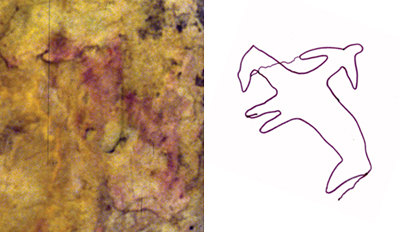A Horse-and-Rider Pictograph
By Deborah Sabo Arkansas has only a single known authentic rock art image of a horse. It is very faded and indistinct, but it is also very interesting because it is an equestrian image: a horse-and-rider. This pictograph, made with red paint, is at a site in Washington County. It is important because depictions of horses must be of historic date. Although horses evolved in North America during the Eocene, they became extinct on this continent by the end of the Ice Age. (To read about the evolution of the horse, click here.) Horses were reintroduced to North America by Europeans in the sixteenth century. We don’t know for certain how Arkansas Indians first acquired horses. The first European horses to enter Arkansas were those belonging to Hernando de Soto’s army. Soto and his expedition crossed through Arkansas on their search for gold in 1539–43. Some of these animals may have been lost by the Spaniards or captured by Indians along the way, especially when Soto’s men were in distress. Also, from the time of Cortez in Mexico (1519) the Spaniards brought horses to Central America. Many escaped and roamed as wild herds into the Southwest and Southern Plains (including Texas), and were acquired by Indians in those areas. The Caddo Indians were horse traders from the late seventeenth century on, and their neighbors to the east (Osages, Quapaws, Tunicas, etc.) obtained horses from them. While we can’t know an exact date for our pictograph of a horse-and-rider, at least we know it must be after Europeans had entered the Americas, bringing their horses with them.
It is not possible to offer a precise interpretation of this equestrian pictograph. Some people, no doubt, would like to suggest it represents one of Soto’s men on horseback. There is a particular romanticism in Arkansas (and other states) connected to the route of these Spanish explorer/invaders, and local residents like to tell stories about sites the Spaniards might have visited, Spanish graves, and artifacts such as armor or weapons they might have left behind. Archeologists do know about sites the Spaniards visited (for example, the Parkin site in northeast Arkansas), but discovering the locations of these sites is a difficult job that requires a lot of careful research. Most of the local stories about “conquistador helmets” and so on have little evidence to back them up and are a type of folklore. It is more likely that the pictograph shows an Indian (or Euroamerican) person of a later period riding a horse. The only way to get a better idea about it would be if we could date the pigment using special radiocarbon techniques, but this procedure is very expensive, it destroys part of the pictograph, and it is not always successful. |
| Home | Quick Facts | Interpretations | Articles | Technical Papers | Resources | Database | Just For Kids | Picture Gallery | Buy the Book! |
|
Last Updated: January 7, 2009 at 3:57:51 PM Central Time
|

